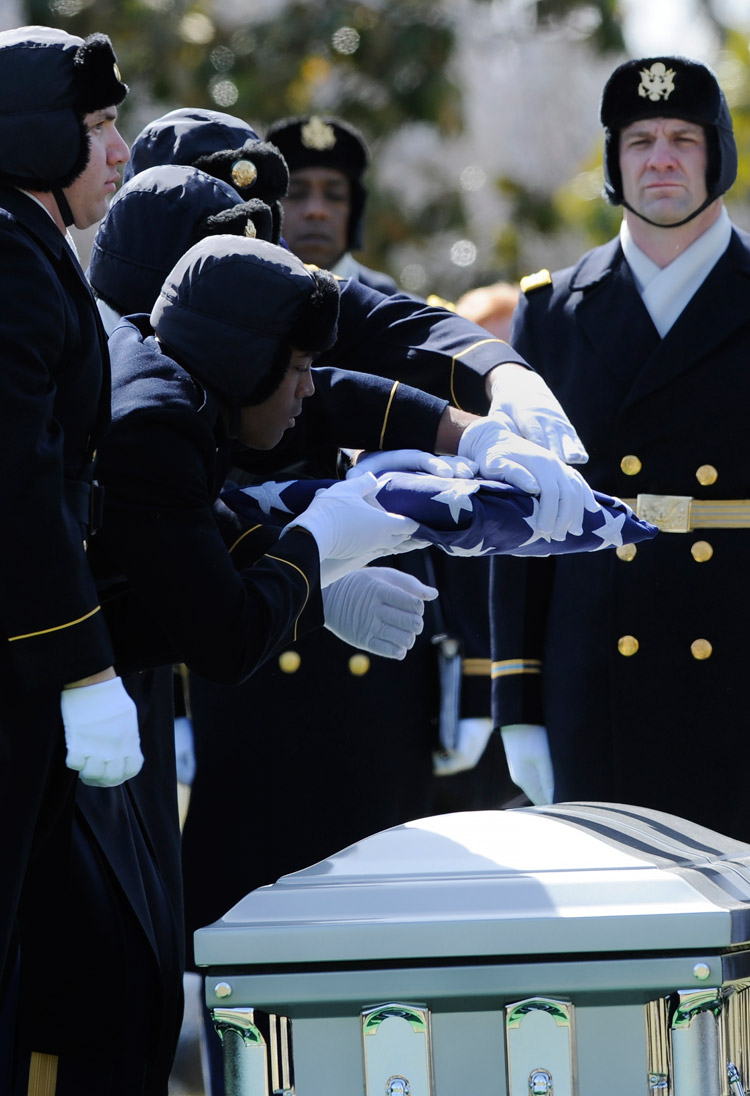ARLINGTON, Va. — The procession to Army Air Corps Tech. Sgt. Charles L. Johnston Jr.’s final resting place was 1.27 miles, but the journey took 70 years, 10 months and 21 days.
The airman’s plane had been shot down by the Japanese in an air attack over New Guinea on April 10, 1944, but it had taken the Army decades to locate and identify his remains.
Now it was time to bring Sgt. Johnston home.
Bill Mall, his first cousin and the only living relative with clear memories of him, planned a funeral in March with full military honors at Arlington National Cemetery. Mr. Mall would receive the sergeant’s medals and the flag that would be draped over his casket.
That was fitting because Chuck Johnston was the childhood hero who inspired Mr. Mall to become a fighter pilot himself, and eventually a two-star Air Force general.
The retired major general also arranged for family members from around the country to come “give the sergeant one last salute.”

But two weeks before the funeral, Mr. Mall learned he wasn’t the next of kin.
In researching this story, the Post-Gazette located other relatives of Sgt. Johnston, the children of his brother Robert, who had died in 2004. A genealogist hired by the Army had tried to find Mr. Johnston or his descendants, but was unable to locate anyone. But a Post-Gazette librarian was recently able to find an online obituary about Robert Johnston that listed surviving family members. The website was not online at the time the genealogist was searching for the Johnston family.
The Post-Gazette notified the Army that it had located other relatives of Sgt. Johnston. Among them was Terri Gelbart of San Diego, who is the daughter of Robert Johnston and the niece of Sgt. Johnston.
After being contacted by Army officials and notified of the death of her late uncle, Mrs. Gelbart said she and her three siblings were stunned that the mystery surrounding her late uncle had been solved.
“We thought, how could this be?” she said.
Next came disappointment. The funeral had already been planned for March 2. None of Robert Johnston's family could get to Arlington by then. As the newly identified next-of-kin, Mrs. Gelbart could have nixed Mr. Mall’s plans but she didn’t have the heart.
Mr. Mall and his family – all cousins Mrs. Gelbart didn’t even know about – had already made travel arrangements to go to Arlington.
Mrs. Gelbart was relieved, though, to learn there would be a second ceremony, also with military honors. On March 17, the comingled remains of Sgt. Johnston's crew that were too small to be identified would be buried together.
“How could we get so lucky that there were two ceremonies? And with [Mr. Mall] being military, I’d rather have him be at the main one,” Mrs. Gelbart said.
She, her brother Keith and his grown son Christopher booked flights from California and Florida.
“I just wish my dad would have been around and my grandmother. It’s sad to lose your first child, your first son,” she said.
That’s why when she attended the services on March 17 she carried her grandmother’s photo as she made her way from a chapel at Joint Base Myer-Henderson Hall to Section 60 of Arlington National Cemetery.
Fifteen days earlier, Mr. Mall and 10 other relatives made the same procession, some on foot and some in cars that rolled past thousands of white markers including some that bore a single word: Unknown.
En route, descendants teared up, even those like Megan Mall of York, who hadn’t even heard of her fourth cousin Chuck until recently.
“It’s emotional because even though I didn’t know him I have all my opportunities because of people like him,” said Megan, who at 18 is just two years younger than her cousin was when he flew his fatal mission.

Horses drew a caisson ahead of the U.S. Army Band “Pershing’s Own,” a firing party, a color guard, a bugler and a phalanx of soldiers from the Army’s 3rd U.S. Infantry Regiment, who rendered full military honors.
“We’re not doing this for show. … We’re doing it because your cousin served our nation with pride and distinction,” U.S. Army Chaplain Lt. Col. Timothy L. Hubbs had told the family gathered in the chapel before the procession.
“Now he will rest peacefully at Arlington National Cemetery, shoulder-to-shoulder with other members of the greatest generation of Americans,” he said. “Let us take this hero to his final resting place.”
Previous Chapter